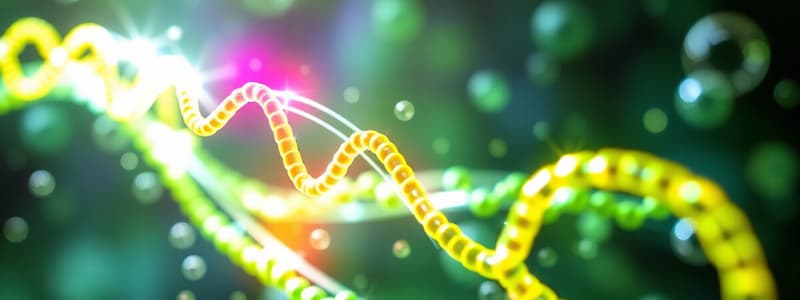Podcast
Questions and Answers
What does a graph of an endergonic reaction typically show?
What does a graph of an endergonic reaction typically show?
- An upward slope indicating energy absorption (correct)
- A flat line with no change in energy
- A downward slope indicating energy release
- A peak followed by a sharp drop in energy
What is the primary role of ATP in biological processes?
What is the primary role of ATP in biological processes?
- To synthesize amino acids
- To transport oxygen in blood
- To provide energy for cellular activities (correct)
- To store genetic information
What characterizes a catabolic reaction?
What characterizes a catabolic reaction?
- It stores energy in chemical bonds
- It only occurs in photosynthesizing organisms
- It breaks down molecules and releases energy (correct)
- It synthesizes larger molecules from smaller ones
During which process are NAD and FAD primarily utilized?
During which process are NAD and FAD primarily utilized?
What effect does a competitive inhibitor have on an enzyme's function?
What effect does a competitive inhibitor have on an enzyme's function?
What occurs during the Krebs Cycle (Citric Acid Cycle)?
What occurs during the Krebs Cycle (Citric Acid Cycle)?
What is the primary function of enzymes in biochemical reactions?
What is the primary function of enzymes in biochemical reactions?
What characterizes an exergonic reaction?
What characterizes an exergonic reaction?
Flashcards are hidden until you start studying
Study Notes
Kinetic Energy
-
Kinetic energy is specifically related to the speed and mass of an object. It plays a crucial role in understanding various physical phenomena and is essential in fields such as mechanics and engineering.
-
Energy of motion
-
The faster an object moves, the greater its kinetic energy
-
Examples: a moving car, a flowing river, a bouncing ball
Energy Transformation Efficiency
- Energy transformations are never 100% efficient
- Some energy is always lost as heat
- Heat is a form of energy that is difficult to utilize for other purposes
ATP Structure and Function
- Adenosine triphosphate (ATP) is the primary energy currency of cells
- Composed of an adenine base, a ribose sugar, and three phosphate groups
- The bonds between the phosphate groups store energy, which is released when a phosphate group is broken off
Catabolic Reactions
- Break down complex molecules into simpler ones
- Release energy
- Examples: digestion of food, cellular respiration
Anabolic Reactions
- Build up complex molecules from simpler ones
- Require energy
- Examples: protein synthesis, DNA replication
Enzyme Function
- Biological catalysts that speed up chemical reactions without being consumed in the process
- Enzymes lower the activation energy of a reaction, making it easier for the reaction to occur
- They do this by providing an alternative reaction pathway with a lower activation energy
Competitive vs Noncompetitive Inhibition
- Competitive inhibition occurs when an inhibitor binds to the active site of an enzyme, preventing the substrate from binding
- Noncompetitive inhibition occurs when an inhibitor binds to a site on the enzyme other than the active site, changing the enzyme's shape and making it less active
Endergonic Reactions
- Require energy input
- Products have more energy than reactants
- Graph: The products are higher than the reactants on the y-axis
Exergonic Reactions
- Release energy
- Products have less energy than reactants
- Graph: The products are lower than the reactants on the y-axis
Activation Energy Location on Graphs
- The activation energy is the difference in energy between the reactants and the transition state
- On both endergonic and exergonic reaction graphs, the activation energy is the vertical distance from the reactant level to the peak of the curve
Feedback Inhibition
- A metabolic pathway's product can inhibit earlier steps, regulating pathways and preventing overproduction, e.g., ATP inhibits glucose breakdown.
Cellular Respiration Reaction
- Reaction: C6H12O6 + 6O2 → 6CO2 + 6H2O + energy (ATP)
- Catabolic reaction
- Occurs in the cytoplasm and mitochondria
Plants and Cellular Respiration
- Plants do undergo cellular respiration. They require ATP for normal cell function.
- They produce glucose via photosynthesis, and use that as a source of energy in cellular respiration
Redox Reactions and Cellular Respiration
- Redox reactions are reactions where electrons are transferred from one molecule to another
- Oxidation is the loss of electrons
- Reduction is the gain of electrons
- Redox reactions are critical in cellular respiration
- They occur in the electron transport chain
Oxidation
- Loss of electrons
- Often accompanied by the loss of hydrogen atoms
- Increasing oxidation state
Glycolysis
- Occurs in the cytoplasm
- Glucose is broken down into two pyruvate molecules
- Produces 2 ATP and 2 NADH
Krebs Cycle (Citric Acid Cycle)
- Occurs in the mitochondrial matrix
- Pyruvate is further oxidized to carbon dioxide
- Produces 2 ATP, 6 NADH, and 2 FADH2
Electron Transport Chain
- Occurs in the inner mitochondrial membrane
- Electrons from NADH and FADH2 are passed along a series of electron carriers, releasing energy
- Energy is used to pump protons across the membrane, creating a proton gradient
- Protons flow back across the membrane through ATP synthase, producing ATP
- Produces approximately 32 ATP
NAD and FAD in Cellular Respiration
- NAD+ and FAD are electron carriers
- They accept electrons and become reduced (NADH and FADH2)
- Then they donate electrons to the electron transport chain
Oxygen's Role in Cellular Respiration
- Oxygen is the final electron acceptor in the electron transport chain
- It combines with protons and electrons to form water (H2O)
- This process is essential for maintaining the proton gradient that drives ATP production
Lactic Acid Fermentation
- Occurs in the absence of oxygen
- Pyruvate is converted to lactate
- Produces very little ATP
- Occurs in muscle cells during intense exercise
Alcoholic Fermentation
- Occurs in the absence of oxygen
- Pyruvate is converted to ethanol and carbon dioxide
- Used by yeast and some bacteria
Cellular Respiration Process
- Glycolysis: Glucose is broken down into pyruvate in the cytoplasm, producing 2 ATP and 2 NADH.
- Krebs Cycle: Pyruvate is further oxidized, producing 2 ATP, 6 NADH, and 2 FADH2 in the mitochondria.
- Electron Transport Chain: Electrons from NADH and FADH2 are passed along a series of carriers in the inner mitochondrial membrane, generating a proton gradient that drives ATP synthesis. The final electron acceptor is oxygen, which forms water.
Photosynthesis Reaction
- Reaction: 6CO2 + 6H2O + light energy → C6H12O6 + 6O2
- Anabolic reaction
- Occurs in the chloroplasts of plant cells
Gas Exchange in Plants
- Gases enter and exit the leaf through tiny pores called stomata
- Carbon dioxide enters for photosynthesis
- Oxygen produced during photosynthesis exits
Photosynthetic Pigments
- Photosynthetic pigments are located in the thylakoid membranes of chloroplasts
- These pigments absorb light energy
Light-Dependent Reactions
- Light energy absorbed by chlorophyll in thylakoid membranes excites electrons, producing ATP and NADPH, while splitting water and releasing oxygen.
Light-Independent Reactions (Calvin Cycle)
- In the chloroplast stroma, carbon dioxide is converted into glucose using ATP and NADPH.
Electron Flow in Photosy
Products of Light-Dependent Reactions
- ATP and NADPH are produced during the light-dependent reactions
- These are sent to the Calvin Cycle to drive the process of carbon fixation
Main Colors for Photosynthesis
- Photosynthesis is mainly driven by red and blue light
- Chlorophyll absorbs most wavelengths of light except for green, which is reflected
- This is why plants appear green
Studying That Suits You
Use AI to generate personalized quizzes and flashcards to suit your learning preferences.




